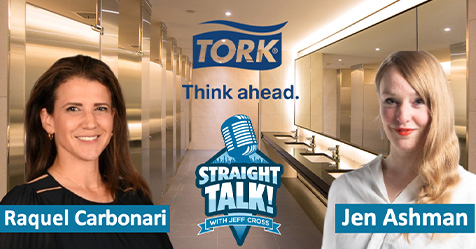Odor: It is a problem in commercial facilities that stinks, but it’s a top concern and one of the most difficult problems confronting cleaning professionals today.
Whether it’s an office building, hotel, restaurant, school, athletic facility, or other business, patrons often first interact with the environment through smell. The smells they encounter communicate the quality and cleanliness of that space, and for businesses, a bad first impression can have consequences.
Three-in-four Americans are disgusted by urine odors in public restrooms, and nearly half would likely tell friends to avoid businesses based on restroom cleanliness, according to a 2013 survey of 1,005 adults by Clorox Professional Products Co. and Opinion Research Corp.
Odors by the Numbers
To get a front-line perspective on the issue, Clorox Professional Products Co. conducted a new survey on the top odor control challenges cleaning industry decision-makers and end users face in commercial facilities. More than 400 cleaning industry professionals—including building service contractors, education facility managers, hospitality facility managers, and long-term care facility managers—participated in the survey.
Seventy-nine percent of cleaning professionals said removing odor from the air was their biggest cleaning challenge, and many of them also identified urine, feces, vomit, mildew, body odor, smoke, or garbage odors as the most difficult to tackle. Not surprisingly, odors in restrooms and garbage areas are toughest to combat. Respondents also said garbage and restroom odors generate the most complaints.
While the survey results underscored the scope of the problem associated with commercial odors, they also revealed that many products currently available are not fully addressing professional cleaning needs. More than half of those surveyed said their current odor elimination solution is just covering up odors, not fully removing them from the air, and they need solutions that are scientifically proven to remove bad odors.
Below are several steps day-to-day cleaning and maintenance personnel can take to control odors in their facilities before they become a problem.
Identify Your Odor
The first step in establishing effective odor-elimination protocols is to identify the type and source of the odor causing problems in various odor hot-spots. Is the odor incidental to an area’s daily use, or is it a recurring challenge inherent to the function of the space?
Incidental, or daily odor, in an office break room or hotel room might be caused by food or overflowing garbage bins. Recurring odoris common in areas like high-traffic public restrooms where unpleasant smells are the natural byproduct of their function and frequent use. In commercial facilities, in-house custodial professionals and building service contractors often need to contend with both types of odors, and can do so by using protocols designed to eliminate the toughest odors at their source and from where they linger on soft surfaces and in the air.
Select the Right Tools
Before treating any malodor, ensure you have a product that can eliminate, not just mask, the problem. Air fresheners can provide temporary relief, but simply adding other fragrances does not eliminate or address the odor’s underlying cause. In fact, 46 percent of surveyed cleaning professionals who have issues with an air odor elimination product say they receive complaints about fragrance.
When possible, also look for products that work on hard and soft surfaces. Porous damp surfaces, such as grout, can trap urine and the bacteria that feeds on it, and humid conditions or wetting the surface can reactivate the odor.
Arm Yourself and Spray
Armed with the right tools, the following steps can serve as part of existing cleaning protocols to remove daily odors from soft surfaces and the air:
- If soil, gross filth, or a stain is visible on soft surfaces or in the area, spray the odor elimination product on the soil to remove the smell.
- Remove any soil present on surfaces. For spoiled or stained soft surfaces, spray the odor elimination product on the surface until it is slightly damp to remove any remaining odor.
- Spray the odor-elimination product into the air with a side-to-side sweeping motion. Start in the area farthest from the exit and move toward the exit until the whole room has been treated.
- Consider adding a timed-metered aerosol spray to address recurring malodor in the air. Once you’ve selected the appropriate product, install the dispensing cabinet high on a wall near the source of the recurring odor and set the spray interval to approximately25 minutes.
The fight against recurrent odor in problem areas like high-traffic restrooms can feel endless and impossible, but it doesn’t have to be with a two-pronged approach that addresses problems like urine odors at their source and treats recurring odors in the air.


